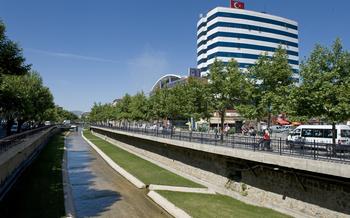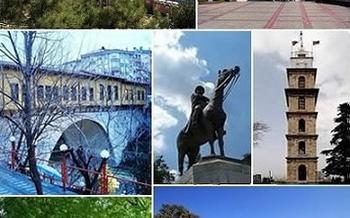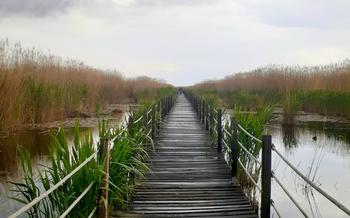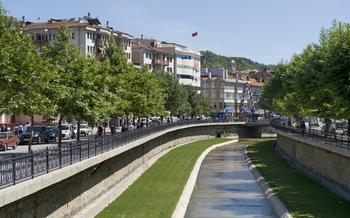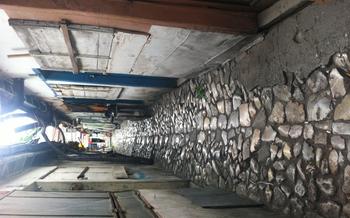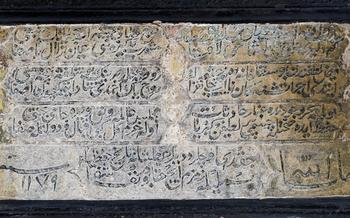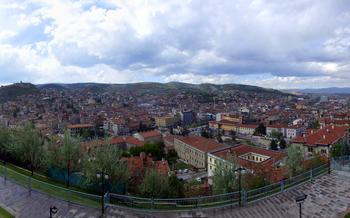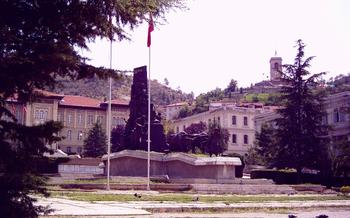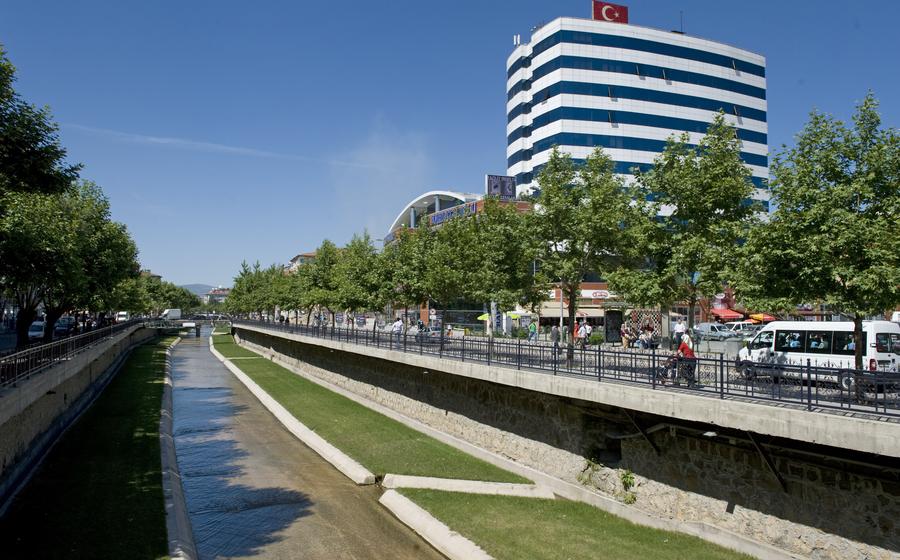
Küre Mountains Ağlı The Black Pine of Şehitlik
- Küre Mountains National Park: A Haven of Biodiversity and Natural Beauty
- Ağlı Waterfall: A Natural Masterpiece in the Heart of the Küre Mountains
- Şehitlik Black Pine
- Gökçesu River: A Scenic Haven for Nature Enthusiasts
- Ilıca Waterfall: A Thermal Oasis in the Heart of Nature
- Köprülü Canyon: A Natural Wonder for Adventure Seekers
- Yenice Forest: A Haven for Nature Enthusiasts
- Kastamonu Castle: A Majestic Symbol of History
- Ethnography Museum
- Clock Tower: A Timeless Landmark in the Heart of Kastamonu
- Grand Mosque
- Ilgarini Hamam: A Journey into History and Wellness
- Safranbolu Houses: A UNESCO World Heritage Treasure
- Incegiz Caves: A Journey into the Depths of Nature's Artwork
- Incegiz Caves:
- Insider Tip:
Küre Mountains National Park: A Haven of Biodiversity and Natural Beauty
The Küre Mountains National Park, established in 1970, stands as a testament to Turkey's commitment to preserving its natural heritage. Nestled in the heart of the Western Black Sea Region, this park encompasses a vast expanse of pristine forests, towering peaks, and cascading waterfalls, offering a sanctuary for a remarkable diversity of flora and fauna.
The park's diverse ecosystems, ranging from lush beech forests to alpine meadows, provide habitats for a wide array of wildlife, including bears, wolves, deer, and a variety of bird species. The Küre Mountains are also home to the endangered Anatolian leopard, making it a crucial conservation area for this magnificent feline.
For nature enthusiasts, the park offers a plethora of activities, including hiking trails that wind through dense forests and lead to breathtaking viewpoints. Guided tours are available, providing visitors with insights into the park's rich biodiversity and its significance as a protected area.
Ağlı Waterfall: A Natural Masterpiece in the Heart of the Küre Mountains
Nestled amidst the lush forests of the Küre Mountains National Park, Ağlı Waterfall stands as a testament to nature's artistic prowess. Its cascading waters, plunging from a height of 51 meters, create a mesmerizing spectacle that draws visitors from far and wide. The waterfall's name, "Ağlı," which translates to "weeping" in Turkish, is a nod to the gentle mist that envelops the area, creating a sense of tranquility and awe.
Reaching Ağlı Waterfall requires a scenic hike through the park's verdant trails, offering breathtaking views of the surrounding landscape. The waterfall's unique beauty is further enhanced by the surrounding rock formations, which have been shaped over millions of years by the relentless force of water. Local legend has it that the waterfall's tears are a symbol of sorrow for a lost love, adding a touch of mystique to this natural wonder.
For photography enthusiasts, Ağlı Waterfall presents a multitude of opportunities to capture stunning images. The interplay of light and water, combined with the vibrant colors of the surrounding flora, creates a canvas that is both captivating and serene. Whether you choose to capture the waterfall's full majesty from a distance or venture closer to admire its intricate details, Ağlı Waterfall promises a feast for the senses.
To fully experience the beauty of Ağlı Waterfall, visitors can embark on one of the many hiking trails that lead to its base. These trails offer varying levels of difficulty, catering to both seasoned hikers and those seeking a more leisurely stroll. Along the way, hikers can immerse themselves in the park's rich biodiversity, encountering diverse plant and animal species that call this pristine wilderness home.
Ağlı Waterfall is a true gem within the Küre Mountains National Park, inviting visitors to witness the raw power and elegance of nature. Whether you seek solace, adventure, or simply the chance to marvel at the wonders of the natural world, this majestic waterfall promises an unforgettable experience.
Şehitlik Black Pine
The Şehitlik Black Pine, a towering symbol of resilience and remembrance, stands tall in the heart of Kastamonu. This majestic tree, estimated to be over 600 years old, holds a deep historical significance for the people of the region. During the Ottoman era, the tree served as a gathering place for soldiers preparing for battle. The soldiers would pray beneath its branches and seek blessings for their victory. As a result, the tree became known as the "Şehitlik Black Pine," derived from the Turkish word "şehit," meaning "martyr."
The Şehitlik Black Pine stands as a testament to the sacrifices made by countless brave soldiers throughout history. Locals regard it as a symbol of courage, honor, and the unwavering spirit of those who fought for their land. The tree's immense size and longevity further add to its mystique, inspiring awe and respect among visitors.
In recent years, the Şehitlik Black Pine has become a popular tourist destination. Its historical significance and natural beauty attract travelers from far and wide. The tree is easily accessible, situated in a well-maintained park that invites visitors to relax and reflect on the rich history it represents.
Gökçesu River: A Scenic Haven for Nature Enthusiasts
The Gökçesu River, a natural wonder located in Kastamonu, Turkey, captivates visitors with its serene beauty and wealth of recreational opportunities. Originating from the Ilgaz Mountains, the river meanders through picturesque landscapes, creating a haven for nature lovers and adventure seekers alike.
As the river flows, it carves its way through diverse terrains, forming breathtaking gorges, cascading waterfalls, and inviting pools. Along its course, the Gökçesu River meets the Devrekani River, creating a confluence that further enhances the region's scenic charm.
The river's crystal-clear waters invite visitors to immerse themselves in a refreshing swim or engage in exciting fishing expeditions. Anglers can cast their lines and try their luck at catching trout, a prized species found in the river's depths.
Beyond fishing, the Gökçesu River offers a range of other recreational activities. Visitors can embark on leisurely boat rides, allowing them to admire the surrounding scenery from a unique perspective. Kayaking and canoeing are also popular choices, providing an exhilarating way to explore the river's tranquil waters.
Local legends and folklore add to the allure of the Gökçesu River. One tale speaks of a mythical creature known as the "su پری" (water fairy) who is said to reside in the river's depths, enchanting visitors with her beauty and grace.
Whether you seek relaxation, adventure, or a glimpse into local traditions, the Gökçesu River offers a captivating experience for every traveler.
Ilıca Waterfall: A Thermal Oasis in the Heart of Nature
Nestled amidst the picturesque landscapes of Kastamonu, the Ilıca Waterfall beckons travelers with its enchanting allure. Located in the Ilıca neighborhood, this natural wonder is easily accessible, inviting visitors to immerse themselves in its tranquil beauty.
The waterfall cascades gracefully from a height, creating a mesmerizing spectacle that captivates the senses. Its crystal-clear waters, infused with minerals from the surrounding rocks, possess therapeutic properties that have been revered for centuries. Locals and tourists alike flock to the Ilıca Waterfall to experience its healing powers and rejuvenate their spirits.
The surroundings of the waterfall exude an aura of serenity, with lush greenery and vibrant wildflowers painting a vibrant tapestry of nature. Visitors can bask in the tranquility of the environment, surrounded by the gentle sounds of cascading water and the sweet melodies of birdsong.
Infrastructure development has ensured that visitors can fully enjoy the Ilıca Waterfall's wonders. Well-maintained paths lead to the base of the waterfall, allowing for up-close encounters with its refreshing spray. Amenities such as seating areas and changing rooms have been thoughtfully provided for the convenience of guests.
Whether seeking solace, revitalization, or simply a chance to connect with nature, the Ilıca Waterfall offers an unforgettable experience. Immerse yourself in its soothing waters, let your worries melt away, and revel in the tranquility that envelops this natural sanctuary.
Köprülü Canyon: A Natural Wonder for Adventure Seekers
Köprülü Canyon, a breathtaking natural wonder located in the Kastamonu province, is a paradise for outdoor enthusiasts and nature lovers. This awe-inspiring canyon, formed by the relentless flow of the Köprü River over millions of years, boasts a diverse landscape of towering cliffs, cascading waterfalls, lush forests, and crystal-clear waters.
Köprülü Canyon is an ideal destination for those seeking adventure and exploration. Whether you're an avid hiker, a thrill-seeking trekker, or a camping enthusiast, this canyon has something to offer. With designated trails winding through the rugged terrain, hikers can embark on a journey of discovery, immersing themselves in the canyon's natural beauty.
For those seeking a more challenging adventure, trekking through Köprülü Canyon is an unforgettable experience. The rugged terrain, coupled with stunning views, makes for an exhilarating and rewarding trek. Along the way, trekkers can encounter hidden waterfalls, ancient caves, and unique rock formations that tell the story of the canyon's geological history.
Camping enthusiasts will find Köprülü Canyon an ideal location to pitch their tents and spend a night under the stars. With designated camping areas nestled amidst the serene forests, campers can enjoy the tranquility of nature and the symphony of sounds from the river and wildlife.
Beyond its natural wonders, Köprülü Canyon is also home to several local villages that offer a glimpse into the region's rich culture and traditions. Visitors can interact with the friendly locals, savor delicious traditional cuisine, and learn about the customs and heritage that make this region unique.
Yenice Forest: A Haven for Nature Enthusiasts
Nestled in the heart of Kastamonu, Yenice Forest beckons nature enthusiasts with its verdant expanse and rich biodiversity. Spanning over 10,000 hectares, this enchanting forest boasts a diverse array of tree species, including towering oaks, majestic pines, and vibrant beeches. Its undergrowth teems with a kaleidoscope of wildflowers, providing a feast for the eyes and a haven for butterflies and other pollinators.
Beyond its scenic beauty, Yenice Forest is a sanctuary for a diverse array of wildlife. Red squirrels, agile martens, and elusive roe deer roam freely among the trees, while a variety of bird species, including melodious nightingales and colorful woodpeckers, fill the air with their songs. This rich ecosystem provides ample opportunities for wildlife watching, birdwatching, and photography, allowing visitors to connect with nature and witness the wonders of the forest up close.
In addition to its natural attractions, Yenice Forest offers a range of recreational activities for visitors to enjoy. Well-marked trails wind through the forest, inviting hikers and mountain bikers to explore its hidden corners and discover hidden waterfalls and panoramic viewpoints. Designated picnic areas provide the perfect setting for families and friends to relax and savor the tranquility of the forest while enjoying a delicious meal surrounded by nature's beauty.
Yenice Forest is not just a natural wonderland but also a testament to the importance of conservation and sustainable forestry practices. The local community and authorities have worked tirelessly to protect this precious ecosystem, ensuring that it remains a thriving haven for wildlife and a source of inspiration for generations to come. Visitors to the forest are encouraged to respect and preserve its delicate balance, leaving no trace and taking only memories with them.
Kastamonu Castle: A Majestic Symbol of History
Kastamonu Castle, a proud sentinel overlooking the city, stands as a testament to the rich tapestry of history that Kastamonu holds dear. Its imposing walls, weathered by time, have borne witness to countless tales of valor, intrigue, and resilience. Originally constructed by the Byzantines in the 12th century, the castle served as a strategic fortress, guarding the city from invaders. Over the centuries, it underwent several renovations and expansions, reflecting the changing hands that shaped Kastamonu's destiny.
The castle's architectural grandeur is a testament to the skill and ingenuity of its builders. Its massive stone ramparts, punctuated by sturdy towers, exude an aura of strength and invincibility. Intricate carvings and embellishments adorn the castle's facade, hinting at the cultural influences that have left their mark on Kastamonu.
As visitors explore the castle's labyrinthine interior, they are transported back in time to an era of chivalry and intrigue. Narrow passages, dimly lit chambers, and secret staircases evoke a sense of mystery and adventure. Atop the castle's highest tower, visitors are rewarded with breathtaking panoramic views of Kastamonu and its surrounding landscapes, a vista that has captivated hearts for centuries.
Guided tours of the castle provide a deeper insight into its history and significance. Visitors can learn about the valiant battles fought within its walls, the noble families who once resided there, and the pivotal role it played in shaping Kastamonu's identity. Exhibitions showcasing artifacts, weaponry, and historical documents bring the castle's past vividly to life.
Kastamonu Castle is not merely a historical monument but also a vibrant cultural hub. It hosts a variety of events throughout the year, including concerts, art exhibitions, and historical reenactments, offering visitors a chance to experience the castle's living legacy. Whether exploring its ancient chambers, marveling at its architectural splendor, or simply soaking in the panoramic views, Kastamonu Castle is a must-visit destination for anyone seeking to unravel the rich tapestry of Kastamonu's past.
Ethnography Museum
Located in the heart of Kastamonu, the Ethnography Museum is a treasure trove of cultural artifacts, costumes, and handicrafts that provide a glimpse into the rich traditions and heritage of the region. Housed in a beautifully restored historical building, the museum showcases a diverse collection that includes traditional clothing, jewelry, pottery, carpets, and tools used in daily life.
Visitors can wander through the exhibits and learn about the local customs, beliefs, and practices that have shaped Kastamonu's unique identity. The museum also features interactive displays and educational programs that bring the past to life, making it an engaging and informative experience for visitors of all ages.
Whether you're interested in textiles, handicrafts, or simply want to gain a deeper understanding of the local culture, the Ethnography Museum is a must-visit destination in Kastamonu. Don't miss the opportunity to immerse yourself in the fascinating world of traditional Turkish arts and crafts.
Clock Tower: A Timeless Landmark in the Heart of Kastamonu
Standing tall in the heart of Kastamonu, the Clock Tower is a symbolic landmark that narrates tales of the city's rich history. Built in the 19th century, its architectural design is a blend of Ottoman and European influences, showcasing intricate stonework and decorative elements.
The tower's most distinctive feature is its large clock face, which has faithfully marked the passage of time for over a century. Locals and visitors alike gather around the tower to witness the harmonious chime of the bells, which resonate through the city streets, creating a magical ambiance.
Climbing to the top of the tower is a must-do experience, offering panoramic views of Kastamonu and its sprawling landscapes. From this vantage point, visitors can admire the city's red-roofed houses, the winding Gökçesu River, and the majestic mountains that embrace Kastamonu.
The Clock Tower is more than just a timekeeper; it is a symbol of Kastamonu's resilience and cultural heritage. Local legends and stories intertwine with the tower's history, adding to its allure and significance. Whether admiring its architectural beauty from afar or experiencing the breathtaking views from its summit, the Clock Tower is a captivating landmark that leaves an indelible mark on every visitor.
Grand Mosque
The Grand Mosque of Kastamonu, standing tall and majestic in the heart of the city, is a testament to the region's rich Islamic heritage and architectural prowess. Built in the 16th century during the Ottoman era, this sacred edifice showcases a harmonious blend of Seljuk and Ottoman architectural styles. Its intricate tilework, delicate calligraphy, and ornate decorative elements captivate the eyes, while the spacious prayer hall exudes an aura of serenity and devotion.
As a symbol of religious devotion and community gathering, the Grand Mosque holds immense cultural and historical significance for the people of Kastamonu. Throughout history, it has served as a place of worship, a center for Islamic learning, and a gathering space for communal events. The mosque's enduring presence and architectural grandeur have made it an iconic landmark, representing the deep-rooted faith and traditions of the region.
Visitors to the Grand Mosque are awed by its exquisite craftsmanship and intricate details. The exterior facade is adorned with intricate carvings and decorative panels, each telling a unique story from Islamic history and culture. The interior is equally impressive, with a vast prayer hall adorned with colorful tiles, elegant calligraphy, and shimmering chandeliers. The mihrab, the niche indicating the direction of Mecca, is a masterpiece of Islamic art, featuring intricate geometric patterns and Quranic inscriptions.
Beyond its religious significance, the Grand Mosque also holds cultural and historical value. It has witnessed centuries of transformations, serving as a silent observer of Kastamonu's evolving history. Its walls hold the echoes of prayers, celebrations, and significant events that have shaped the city's identity. Today, the mosque stands as a living testament to the enduring spirit of Kastamonu's Islamic heritage, inviting visitors to immerse themselves in its rich history and spiritual essence.
Ilgarini Hamam: A Journey into History and Wellness
Nestled in the heart of Kastamonu's old town, Ilgarini Hamam stands as a testament to the city's rich history and bathing traditions. Built in the 16th century by the Armenian architect Mimar Sinan, this historic bathhouse is a masterpiece of Ottoman architecture and design.
Cultural Significance and Traditional Rituals Ilgarini Hamam holds a significant place in the cultural heritage of Kastamonu. For centuries, it served as a communal space where locals gathered to socialize, relax, and cleanse both their bodies and spirits. The hammam's traditional rituals, rooted in Islamic bathing customs, involved a series of chambers with varying temperatures and humidity levels, allowing bathers to experience a purifying and rejuvenating journey.
Impressive Architecture and Unique Features The architectural design of Ilgarini Hamam is a sight to behold. Its striking dome-shaped ceilings, intricate tilework, and elegant marble interiors create an atmosphere of grandeur and serenity. The hammam features separate sections for men and women, each with its own set of bathing chambers, massage rooms, and relaxation areas.
Restoration and Current Use In recent years, Ilgarini Hamam underwent extensive restoration efforts to preserve its historical charm while adapting it to modern-day use. Today, it serves as a cultural center and museum, offering visitors a glimpse into the traditional Turkish bathing culture and the history of the hammam.
Exploring the Baths and Cultural Experiences Visitors to Ilgarini Hamam can embark on guided tours to explore the various chambers and learn about the bathing rituals and customs of the past. Interactive exhibits and displays provide insights into the hammam's construction, architecture, and cultural significance.
Whether you're seeking a unique cultural experience or simply want to unwind and relax, Ilgarini Hamam offers a journey into history and wellness, inviting you to step back in time and immerse yourself in the traditions of Turkish bathing culture.
Safranbolu Houses: A UNESCO World Heritage Treasure
Safranbolu, a town in Kastamonu, boasts a remarkable collection of historical houses that have earned it the prestigious designation of a UNESCO World Heritage Site. These houses, with their distinctive architectural style and historical significance, stand as testaments to the town's rich cultural heritage.
Built in the 18th and 19th centuries, the Safranbolu houses showcase a harmonious blend of Ottoman and Turkish architectural elements. Constructed mainly of wood and stone, they feature overhanging eaves, intricate wood carvings, and colorful facades. The houses often have two or three stories, with spacious rooms and courtyards, reflecting the traditional Turkish lifestyle of the period.
The interiors of these houses are equally captivating, with elaborate decorations, hand-painted ceilings, and traditional furnishings. Visitors can explore the houses' various rooms, which served different purposes, such as the selamlık (men's quarters), haremlik (women's quarters), and the kitchen.
Beyond their architectural beauty, the Safranbolu houses hold immense cultural significance. They represent the town's historical role as a center of trade and commerce, with many of the houses belonging to wealthy merchants and traders. The houses also reflect the town's diverse cultural heritage, with influences from different ethnic groups that have inhabited the region over the centuries.
Preservation efforts have been instrumental in maintaining the authenticity and integrity of the Safranbolu houses. Restoration projects have been undertaken to ensure their structural stability while preserving their original architectural features. Today, many of these houses have been transformed into boutique hotels, museums, and cultural centers, allowing visitors to experience the town's history and traditions firsthand.
A visit to the Safranbolu houses is a journey through time, offering a glimpse into the town's rich past and vibrant culture. Whether you choose to explore the houses on a guided tour or wander through the narrow streets at your own pace, the charm and beauty of these architectural gems will leave a lasting impression.
Incegiz Caves: A Journey into the Depths of Nature's Artwork
Incegiz Caves:
Hidden beneath the earth's surface in Kastamonu lies a mesmerizing labyrinth of natural wonders – the Incegiz Caves. These awe-inspiring subterranean chambers, adorned with intricate rock formations and glistening stalactites and stalagmites, invite visitors on an unforgettable journey into the depths of nature's artistry.
Location, Geological Formations, and Unique Features:
Nestled amidst the picturesque landscapes of Kastamonu, the Incegiz Caves are a true geological marvel. Formed over millions of years by the erosive power of water seeping through limestone rock, these caves showcase a breathtaking array of natural sculptures. The labyrinthine network of tunnels, chambers, and galleries reveals fascinating geological formations, including towering columns, delicate curtains, and intricate flowstone patterns.
Guided Tours and Exploration:
To fully immerse yourself in the wonders of the Incegiz Caves, guided tours are available, led by experienced spelunkers who will lead you through the intricate passages and unveil the secrets of this subterranean realm. As you venture deeper into the caves, you'll encounter stunning stalactites and stalagmites in various shapes and sizes, creating a surreal and enchanting atmosphere.
Historical Significance and Archaeological Findings:
Beyond their natural beauty, the Incegiz Caves hold significant historical and archaeological value. Excavations within the caves have unearthed ancient artifacts, including tools, pottery, and animal bones, providing glimpses into the lives of prehistoric inhabitants who once sought shelter within these underground chambers. These findings have shed light on the region's rich cultural heritage and have contributed to our understanding of human history in Kastamonu.
Conservation Efforts and Sustainable Tourism:
To preserve the delicate ecosystem and pristine beauty of the Incegiz Caves, conservation efforts are diligently undertaken. Sustainable tourism practices are implemented to minimize the impact on the cave environment and ensure the long-term protection of this natural wonder. Visitors are encouraged to follow designated paths, refrain from touching or damaging the formations, and respect the fragile ecosystem that these caves support.
Insider Tip:
-
Best time to visit: Spring (April-May) and autumn (September-October) offer the most pleasant weather for outdoor activities. Avoid the hot and crowded summer months (June-August) unless you prefer swimming and sunbathing.
-
Local delicacies: Savor the flavors of Kastamonu's traditional cuisine, including keşkek (a hearty wheat and meat dish), mantı (Turkish ravioli), and erişte (hand-rolled noodles). Don't miss the opportunity to taste local honey, produced from the region's abundant wildflowers.
-
Souvenirs: Bring back unique souvenirs that reflect Kastamonu's rich history and culture. Hand-woven carpets, intricate copperware, and traditional pottery are popular choices. Support local artisans by purchasing their handmade crafts.
-
Transportation: Kastamonu is well-connected by road and rail. Buses and trains offer affordable transportation options, while car rentals provide the flexibility to explore the region at your own pace.
-
Communication: Although English is not widely spoken in Kastamonu, basic communication should not be a significant issue. Many locals are eager to assist visitors, and gestures and smiles can often bridge language barriers.
